This article will describe the locomotive which for several decades formed the basis on DSB's railroad network in Denmark and which still - now more than 50 years from the arrival of the first one to Denmark - can be met on the railroad streches of the Danish private railroads.
This locomotive was not only used in Denmark - also in several other European countries was the General Motor engine especially widespread. And just as in Denmark this type can still be seen in operative service by foreign railway companies.
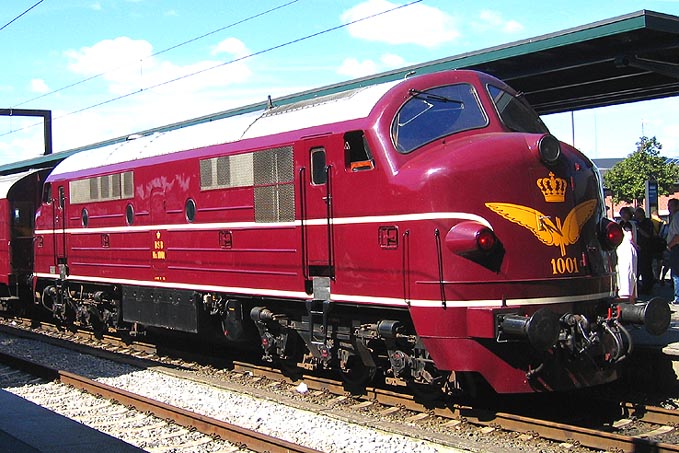
| MX 1001 photographed in Odense 14. August 2004 when celebrating the Danish Jernbane Museum's Gold jubilee of the locomotive in Denmark. |
The beginning
In the beginning of the 1950's the greatest part of the traction power with the Danish National Railroad (DSB) was formed by the steam locomotives. Owing to changing development in the traffic pattern DSB badly needed simultaneosly a more powerful, quicker and more economic locomotive.
A group of experts had over a period examined the different possiblities and they took a special interest in an type of engine from General Motors in USA. A type of engine which already in the beginning of the 1950' was produced in more than 7,000.
From Danish side it was required to get a likely future production to Denmark, but General Motor had given the Swedish company Nydquist & Holm Aktiebolag (NOHAB) license to production of the diesel lokomotives - a license agreement not making further licenses in the Northern European area possible.
The results of the Danish negotiations with General Motor and NOHAB were that calculations were made as to what could be yielded by putting in service 6 diesel lokomotives on the stretch from Nyborg to Frederikshavn.
Based on this analysing process NOHAB made a quotation for a locomotive based upon the most used type in USA - naturally adapted to the conditions of the Danish railway net, e.g. a lower axle load provided by an increase of the number of axles from 4 to 6.
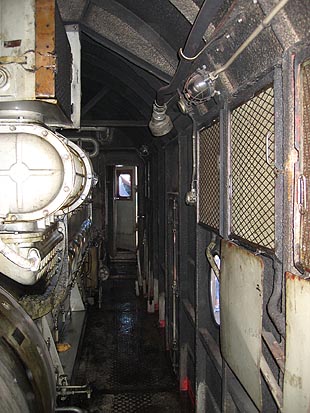 Engine room in MY. |
The type of locomotive offered was to be provided with a General Motor 16 cylindered V-motor type 567 B 2- stroke performing 1.700 h.p. Main dynamo and traction motors were also from General Motors.
Employment of Danish subsuppliers DSB's requirements for an American locomotive built in Sweden caused some political opposition because all former orders for locomotives had been placed with Danish manufacturers. However, DSB could prove that no Danish company had been able to present quotations for delivery of a similar locomotive both being versatile in its applications and being tested in service. DSB could also call attention to the fact that Danish attempts to producing diesel locomotives had given no successfull results up till now. Through negotiations between DSB and NOHAB it was succeeded to obtain an agreement that the Danish company Frichs A/S could be supplier of a quite considerable number of the mechanical parts for the locomotive. |
The first 4 locomotives being ordered
Finally DSB was authorized to purchase 4 locomotives from NOHAB. The 4 locomotives MY 1101 to 1104 were ordered on 4. March 1952. Delivery was agreed to take place in the beginning of 1954.
The first locomotive was to be built solely by NOHAB, while the other 3 should be built with Frichs A/S as subsupplier. As already mentioned Frichs was to supply the mechanical parts, such as locomotive housing and bogies. The final assembling of the locomotives was to be made by NOHAB.
Delivery and trial runs
Naturally,the final take over of the first locomotive MY 1101 did not happen until trial runs were made, first in Sweden and then in Denmark. Being the first non-steam powered big locomotive in Denmark, these trial runs were made with great thorougness and followed with great interest both from DSB as well as from the politicians.
The trial runs in Denmark took place in February 1954 and took place on the distance between Nyborg and Frederikshavn, because it was primarily here the first 4 locomotives were to be inserted. But it was also here the biggest rise on the main railroad network could be found. The trial runs were effected by the heaviest trains in service in this period, i.e. passenger trains, (express trains) consisting of 15 coaches (weight of train 500 tonnes) and goods trains with 60 waggons (weight of train 1,000 tonnes). Several of the trial runs were effected during difficult weather conditions with snow and gales.
The trail runs went very successfully. Beyond the technical measurements - e.g. pressure in the traction motors regarding temperature - it was also required to estimate whether the locomotives could meet the expectations to improved running times and economy. A number of time measurements were effected on the distance between Nyborg and Frederikshavn. The results showed that MY in practice could run the distance by different types of trains more rapid than previous calculations had promised. For the first time an express train with 500 seats drawn by a locomotive yielded practically the same running times up till now alone reached by the LYNTOG's which, however, had a much lesser passenger capacity. Also regarding economy the trial runnings proved that the calculated savings in relation to steampower could last.
Finally can be mentioned that the driver's cabs in the new locomotive offered an improved and more comfortable working place for the engine drivers.
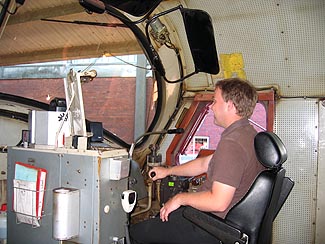 |
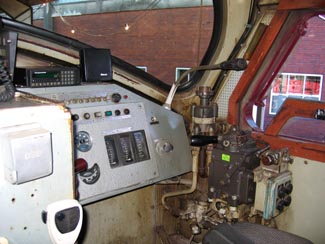 |
| Driver's cabin in MY. |
The first service results
After the successfull trial runs DSB could finally take over MY 1101. The good results from the trial runs did also continue in real life service. And it was also a great advantage that goods trains being so heavy that 2 steam locomotives were previously needed now could be pulled by the MY- locomotive alone - without any extension of the driving time.
In the end of April 1954 the MY 1102 was put in service. In the railroad stretches in Sealand trial runs by MY 1102 were effected with the same good results as was the case for MY 1101. MY 1103 and MY 1104 were also ready for delivery during spring 1954.
It was especially exciting to see if the real service-life could fullfil the positive expectations concerning the economy of the locomotives. So it could. In the period from 15. June 1954 to 30 June 1955 the costs to the service and maintenance of the 4 MY-locomotives were closely the same as the same type of costs to the Litra E steam locomotives. It was found that each individual MY- locomotive gave an annual saving of almost 700.000 DKK. Of course it was realized that the maintenance costs for the new locomotives should be especially low and that they would rise over the years. But simultaneously the worldmarket prices for coal were rising while the oil prices were falling. So all things considered the savings of the maintenance costs were revolutionary compared to the old steampower.
After being in service for 3 years it was a fact that the 4 locomotives had recovered their own expenses, having brought larger savings in the maintenance costs than their purchase price being approx. 1.800.000 DKK per locomotive.
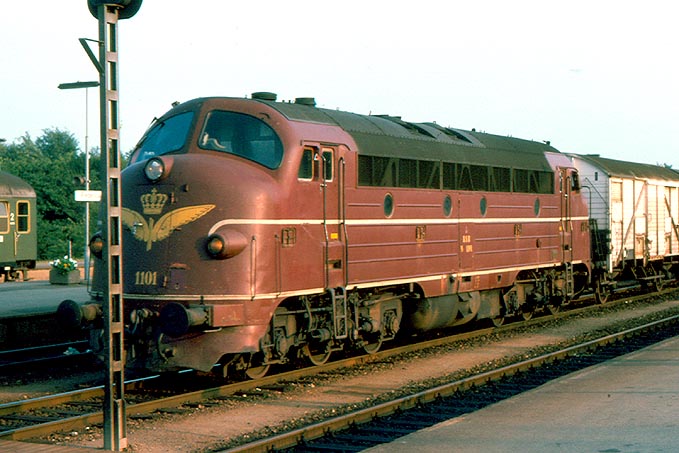
| MY 1101 photographed at the railway station in Fredericia August 1975. |
Further purchases
With the delivery of the 4 first MY locomotives the steam power in Denmark was not terminated yet. It still formed the basis being the traction power for the trains pulled by locomotive.
The good experiences won by MY 1101 - 1104 led however to an increased desire as to further the shift from steam to diesel power. Again a serial of negotiations were necessary before DSB was permitted to enter a contract on purchasing more locomotives. The approval was ensured by giving orders to Danish sub-suppliers for 35% of the contract price as stated in the agreement with NOHAB. Beyond Frichs A/S being chosen to deliver the same elements as to the first 4 locomotives, the company Thomas B. Thrige in Odense and A/S Titan in Copenhagen were to supply important parts for the new locomotives, such as the dynamos.
Thus an order for 20 locomotives numbered as MY 1105 - MY 1124 were placed in November 1954. The new locomotives should mainly be like the first 4 locomotives delivered. Of course a number of tecnical improvements based on the general technologic development and on experiences made from the first locomotives would be made. A great difference was that the performance of the diesel engines of the new batch was to be increased from 1700 hp to 1950 hp.
MY 1105 - MY 1134 were to be delivered in the course of 1956 with most of them delivered before the summer schedule. Only in this way it was possible to make thorough improvements already from the implementation of the new schedule - especially in the regional traffic.
Already before the 20 locomotives were delivered DSB placed an order for further 20 MY-locomotives. The reason being that the prices for coal in 1955 had risen considerably making the savings by changing to diesel power even bigger.
End of steam power
In connection with international railway co-operations through UIC investigations were made from 1956 to 1960 regarding economy etc by introduction of diesel power. In 1960 a report was finished which stated the number of diesel locomotives needed for giving up the steam power in Denmark.
The conclusions of the investigation was that a total of 106 locomotives were to be purchased including the already bought locomotives. It was required that 61 of them had a performance of 1950 hp and the remaining 45 1425 hps. Furthermore, The investigation stated 98 diesel shuttle locomotives were to be purchased.
The report had also made calculations from which appeared that the savings pro anno by introduction of total diesel power should make 30% of the purchasing amount for the diesel locomotives.
The demand for the 45 locomotives with a lesser performance was necessitated by the requirement for traction to DSB's branch lines not permitting quite so high an axle load which was the case for the MY. On the other hand the lenght of the branch line trains did not require so powerful locomotives and the lower weight could thereby be gained by reduction of the performance.
Orders for more diesel locomotives Litra MX and MY
Consequently 45 locomotives of LITRA MX were ordered. These locomotives were mainly equivalent to the MY locomotives to look at. As mentioned they performed 1425 hps. They weighed 89 tonnes and with a 3 axle boogie the axle load were decreased to the 16 tonnes being the upper limit on some of the branch lines.
| The new serial were built like the others by NOHAB under license from General Motors. They were numbered MX 1001 - MX 1045. They were delivered from 1960 to 1962.
To reach the number of locomotives required a further 15 MY locomotives were ordred - MY 1145 to MY 1159. These locomotives were delivered in 1964 and 1965. Thus the total number of MY and MX locomotives from NOHAB reached a total of 104. |
 |
| Factory badge on MX 1001. |
The last 2 locomotives (up to the 106 recommended by the report) were a little different from their sisters - although built according to the same concept - but by Danish manufactures and equipped with B&W diesel engines performing 1700 hps. (MY 1201 and MY 1202). These locomotives delivered in 1957 caused some problems and were scrapped and broken up already in 1971.
Samme lokomotivtype i andre europæiske lande.
Also several other European countries purchased almost identical locomotives from General Motors.
Thus the locomotive type were purchased by Norway, Belgium, Luxemburg and
Hungary.
Beyond NOHAB the locomotive manufactury plant of AFB ANglo-Franco-Belge was given license to produce General Motors locomotives. AFB has consequently built the locomotives for Belgium and Luxemburg while NOHAB has built the locomotives for Norway and Hungary.
In relation to the Gold anniversary in Denmark for the introduction of the locomotive the Danish Railway Museum was the host for a special event to which they succeeded in having present a locomotive from each of the countries originally having bought the locomotive.That the Hungarian locomotive from MAV could be present was due to a personal effort from a German private person Klaus Korbacher who raised a privat credit of 17.000 EURO ensuring the costs for the transportation to and from Denmark. Below photos of these foreign locomotives can be seen.
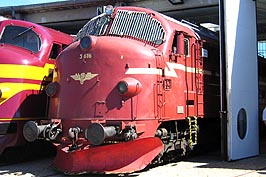 |
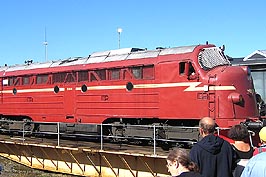 |
|
| NSB Di3.616, Norway - 14. August 2004 | NSB Di3.616, Norway - 14. August 2004 | |
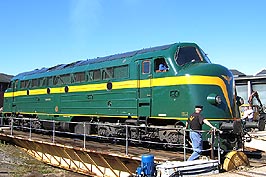 |
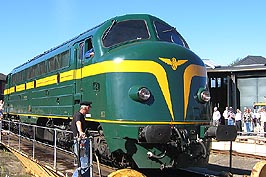 |
|
| SNCB 202.020, Belgium - 14. August 2004 | SNCB 202.020, Belgium - 14. August 2004 | |
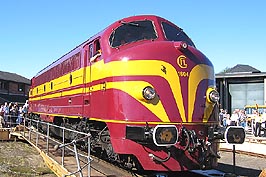 |
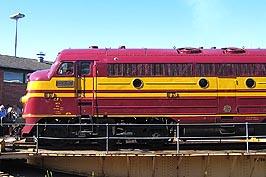 |
|
| CFL 1604, Luxembourg - 14. August 2004 | CFL 1604, Luxembourg - 14. August 2004 | |
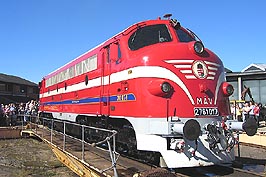 |
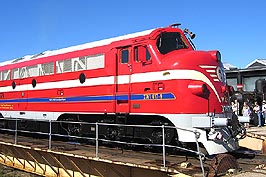 |
|
| MAV M61 017, Hungary - 14. August 2004 | MAV M61 017, Hungary - 14. August 2004 | |
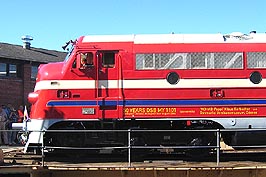 |
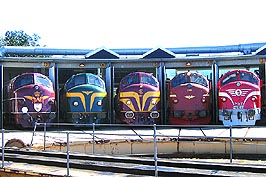 |
|
| MAV M61 017, Hungary - 14. August 2004 | The locomotives from the original 5 countries collected in Odense 14. August 2004. From left to right Denmark, DSB MY 1101, Belgium, SNCB 202.020, Luxembourg CFL 1604, Norway, NSB Di3 616 and Hungary, MAV M61 017. |
Specifikations:
| Country | Class | Manufacturer | Number | Delivered | HP/KW | Max. speed | Wheel arrangement | Remarks |
| Denmark | MY | NOHAB | 59 | 1954-1965 | 1700 hp / 1950 hp | 133 km/h | 1A1-1A1 | My 1101-1104 1700 hk - the rest 1950 hk |
| Denmark | MX | NOHAB | 45 | 1960-1962 | 1425 hp | 133 km/h | 1A1-1A1 | |
| Norway | Di3a | NOHAB | 32 | 1957-1969 | 1775 hp | 105 km/h (org.143) | 1A1-1A1 | |
| Norway | Di3b | NOHAB | 3 | 1960 | 105 km/h (org.143) | 1A1-1A1 | Org. built for broad gauge. | |
| Belgium | 202 | AFB | 18 | 1955 | 1750 hp | 140 km/h | Co'Co | |
| Belgium | 203 | AFB | 19 | 1955 | 140 km/h | Co'Co | ||
| Belgium | 204 | AFB | 8 | 1955-1957 | 140 km/h | Co'Co | ||
| Luxembourg | 1600 | AFB | 4 | 1955 | 1750 hp | 120 km/h | Co'Co | |
| Hungary | M 61 | NOHAB | 20 | 1963-1964 | 1435 kW | 105 km/h | 1A1-1A1 |
The employment of the locomotives with DSB
Both MY and MX locomotives fulfilled quite the expectations in their entire service life. So the locomotives made 's the basis throughout the 1960's of the DSB tractive force - MX with light trains and on the branch lines - MY with mainly all kind of trains - from international express trains to heavy goods trains.
From the delivery the locomotived were painted in a wine red colour - almost brown. Besides the first 24 MY locomotives did not have the number in the front, but it was later added. It was told that it was a wish from the railway interested King Frederik IX who wanted to be able to see the number from his salon coach.
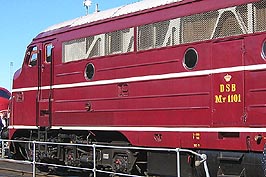 |
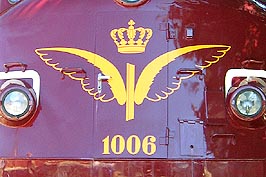 |
|
| MY 1101 in the original colour scheme. | MX had the number at the front by delivery. |
In 1972 DSB make a renovation of its design and painting of all locomotives to a red/black design was begun. The painting was made over many years - the last locomotive was not painted until 1985. A single locomotive the MY 1128 was given an especially remarkable colour scheme in 1988 when it was used for a number of test runs. It was given a "graffiti look". This colour scheme remained when the locomotive later was participating in ordinary service.
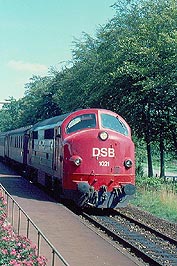 |
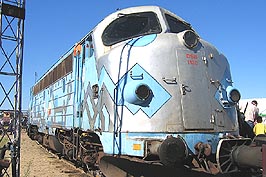 |
|
| MX 1021 in red/black design. | MY 1126 in "Graffiti"-look. Today owned by Dansk Jernbaneklub. |
In the end of 1960's delivery of DSB's new locomotive Litra MZ was begun, like the MY's from General Motors and built by NOHAB. As delivery of these locomotives was effected, it effected the application of the MY and MX locomotives.
In 1974 DSB introduced the new IC-system with the new MZ-locomotives as traction engine. Although the MY's continued to be used as traction engine for the so-called "black high speed diesel trains" as well as for the regional trains on Sjælland consisting of the new Bn/Bns coaches. With a view to application of the driving trailers in these regional trains the locomotives 1110,1112 to 1132 as well as 1145 to 1159 were equipped by ITC (Internal Train Control), so that the locomotives could be operated from the driving trailer.
Both the MY and the MX were gradually more and more used in the goods traffic. When delivery of the litra ME and litra EA to DSB was started from the beginning of the 1980's, the use of the MY and MX was further reduced to a minimum - especially on Sjælland.
The locomotives were, however, heavily used in Jylland and Fyn, but the introduction of the IC3-trains and thus the withdrawal of the Intercity trains drawn by locomotives meant that the working duties to MY and MX from the beginning of the 1990' seriously decimated. By the end of the 1990's the application of the MY on Sjælland was terminated and left was only traffic with a few goods trains in Jylland and Fyn. In the middle of 2001 DSB withdraw the last MY-locomotive from scheduled service.
Today (2005) is only one of these locomotives left with DSB, namely MY 1135 applied as "service locomotive".
Some of DSB's MY and MX locomotives have been broken up or sold as spare part donors after their outphasing from DSB. But the mainparts are sold to continued service with Danish, Swedish or German private railroad companies. Consequently the MY'a and MX's are still extensively used - more than 50 years after delivery of the first locomotive. A few of the Norwegian locomotives have been sold to railroads in Croatia and Italy.
En række glimrende websites fortæller mere om MY og MX-lokomotiverne og enkelte af dem A number of excellent websites tell more about the MY and MX-locomotives and some of them are describing in details what has happened to each locomotive. Among others can be referred to Jernbanen.dk and GM-nyt.dk.
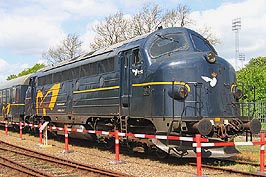 |
>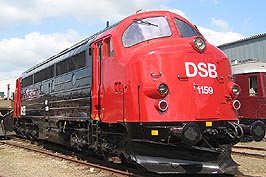 |
|||
| DSB 90 86 00-21 135-7, originally DSB MY 1135. Photographed in Randers 19. May 2007. | DSB MY 1159 (DSB Museumstog) photographed in Randers 19. May 2007. | |||
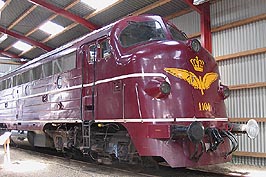 |
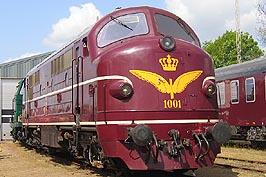 |
|||
| DSB MY 1101 (DSB Museumstog) photographed in Randers 19. May 2007. | DSB MX 1001 (DSB Museumstog) photographed in Randers 19. May 2007. | |||
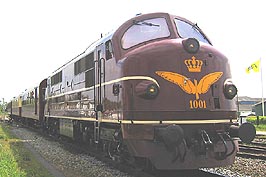 |
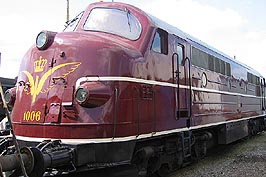 |
|||
| DSB MX 1001 (DSB Museumstog) photographed in Randers 19. May 2007 | DSB MX 1006 (DSB Museumstog) photographed in Randers 19. May 2007. |
Eksempler på lokomotivernes brug på privatbanerne.
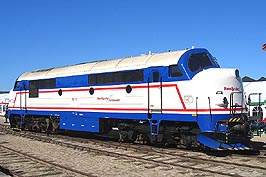 |
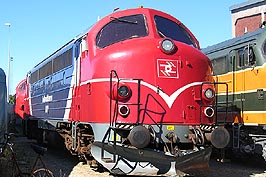 |
|||
| Nordjyske Jernbaner M 11 photographed in Odense 14. August 2004. Originally DSB MX 1009 sold in 1987 to OHJ. Resold to Skagensbanen - now Nordjyske Jernbaner - in 2001. | Lollandsbanen M 38 photographed in Odense 14. August 2004. Originally DSB MY 1153. Withdrawn from service with DSB in 2000. Sold in 2002 to Lollandsbanen. | |||
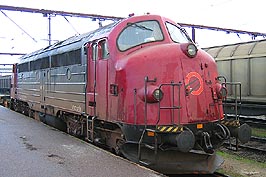 |
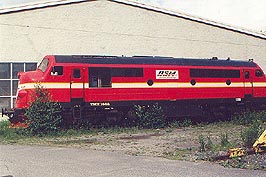 |
|||
| Lemvigbanen (VLTJ) MY 28 photographed in Fredericia 4. December 2004. Originally DSB MY 1152. Sold in 2001 to Lemvigbanen. | BSM (Sweden) TMX 1042 photographed in Sundsvall 17. July 1998. Originally DSB MX 1042. Sold in 1994 to BSX TMX 1042. Resold in 1997 to BSM. | |||
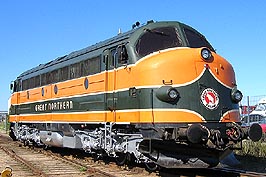 |
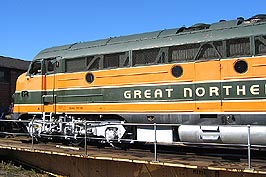 |
|||
| TÅGAB (Sweden) TMY 106 photographed in Odense 14. August 2004. Originaly DSB MY 1108 sold in 1997 to Banestyrelsen. In 1999 resold to TÅGAB. For use with the locomotive's acting in the film "Dancer in the dark" it was painted in the colours of Great Northerns. | ||||
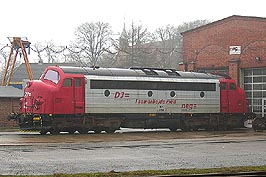 |
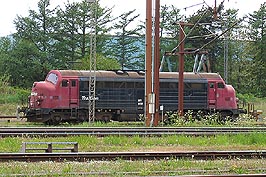 |
|||
| neg MY 1158 photographed in Niebüll 25. March 2005. Originally DSB MY 1158. Sold to VNJ in 2001. In 2004 resold to Dansk Jernbane ApS (NEG) and put in service in 2005. | Traxion MY 1156 photographed in Padborg 14. May 2005. Originally DSB MY 1156. Sold to Traxion in 2001. In service in 2002. In 2003 resold to TGOJ in Sweden. Since 2003 deposited in Padborg. | |||
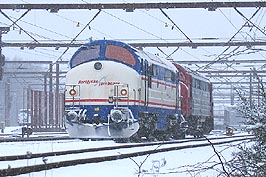 |
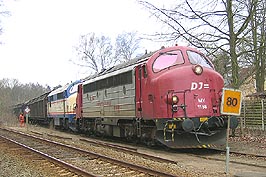 |
|||
| Nordjyske Jernsbaner M 11 photographed in Fredericia 29. December 2005. Behind another MY from Dansk Jernbane. | Dansk Jernbane MY 1158 (freighttrain from Dalum Papirfabrik) photographed in Fruens Bøge by Odense 17. March 2006. Originally DSB MY 1158. Sold to VNJ in 2001. In 2004 resold to Dansk Jernbane ApS (NEG) and put in service in 2005. Behind you see Nordjyske Jernbaner M 11 - originally DSB MX 1009 sold in 1987 to OHJ. Resold to Skagensbanen - now Nordjyske Jernbaner - in 2001. |